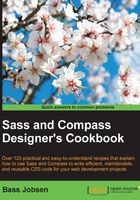
What this book covers
Chapter 1, Getting Started with Sass, gives you an introduction to the Sass language. You will learn how to install and use Sass for your projects on your system, read how to edit your code, and organize your files. It will also tell you why you should use newer SCSS syntax instead of the intended Sass Syntax.
Chapter 2, Debugging Your Code, teaches you how to comment and debug your Sass code. Get introduced to an online tool to test your code and impress with style guides.
Chapter 3, Variables, Mixins, and Functions, showcases the power of Sass. Learn to use variables to define commonly used values at a single place and write reusable code by using mixins and functions.
Chapter 4, Nested Selectors and Modular CSS, explains about the nested selectors and other methodologies to structure your code. Reuse your selectors by extending them and use placeholders to prevent duplicated and unused CSS selectors.
Chapter 5, Built-in Functions, dynamically assigns property values based on your input. Use the built-in functions of Sass, among others, for color values and mathematical operations.
Chapter 6, Using Compass, teaches you to code faster using Compass. Compass contains many useful helper mixins and functions to write clean and reusable CSS code.
Chapter 7, Cross-Browser CSS3 Mixins, helps to write maintainable and cross-browser CSS code. Learn about the CSS3 introduced vendor-specific rules, and read how Sass helps you prefix your code to support different browsers.
Chapter 8, Advanced Sass Coding, uses conditionals and loops to create dynamic code and avoid repeats. Learn how to use prebuilt libraries for vertical rhythms, color contrasts, iconic fonts, and CSS Media Queries.
Chapter 9, Building Layouts with Sass, introduces grid-based layouts, help coders and designers, to work together in a consistent manner. Sass can help you create semantic or responsive grids for your projects.
Chapter 10, Building Grid-based Layouts with Susy and Sass, introduces Susy, which is a Sass add-on for grids; learn how to use it. You can also use Susy to create asymmetric or responsive layouts.
Chapter 11, Foundation and Sass, explores Foundation for Sites 6. Foundation is a responsive frontend framework built with Sass.
Chapter 12, Bootstrap and Sass, explains details about Bootstrap 4. Bootstrap 4 uses Sass now. Learn how to develop mobile first and responsive projects with Bootstrap and Sass.
Chapter 13, Meeting the Bourbon Family, explains about Bourbon, which is a simple and lightweight mixin library for Sass; it helps you write CSS faster and easier without the need of using vendor prefixes.
Chapter 14, Ruby on Rails and Sass, builds web applications with Ruby on Rails (RoR) and Sass. Get to grips with sass-rails to compile the CSS code for your RoR apps.
Chapter 15, Building Mobile Apps, explains that the look and feel of mobile apps may differ from that of other web applications. Get introduced to Frameworks for mobile app development with Sass. Build mobile apps with Foundation for Apps and Ionic.
Chapter 16, Setting up a Build Chain with Grunt, gives introduction to Grunt, a build tool for JavaScript projects. Learn how to create tasks to automatically compile, compress, and prefix your CSS code.